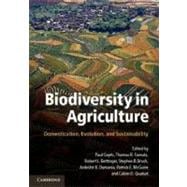
Note: Supplemental materials are not guaranteed with Rental or Used book purchases.
Purchase Benefits
What is included with this book?
| List of tables | p. viii |
| List of figures | p. x |
| Foreword | p. xv |
| List of contributors | p. xvii |
| Acknowledgments | p. xxiii |
| Introduction: The Domestication of Plants and Animals: Ten Unanswered Questions | p. 1 |
| The Local Origins of Domestication | p. 9 |
| Early Steps in Agricultural Domestication | |
| Evolution of Agroecosystems: Biodiversity, Origins, and Differential Development | p. 21 |
| From Foraging to Farming in Western and Eastern Asia | p. 57 |
| Pre-Domestic Cultivation during the Late Pleistocene and Early Holocene in the Northern Levant | p. 92 |
| New Archaeobotanical Information on Plant Domestication from Macro-Remains: Tracking the Evolution of Domestication Syndrome Traits | p. 110 |
| New Archaeobotanical Information on Early Cultivation and Plant Domestication Involving Microplant (Phytolith and Starch Grain) Remains | p. 136 |
| How and Why Did Agriculture Spread? | p. 160 |
| California Indian Proto-Agriculture: Its Characterization and Legacy | p. 190 |
| Domestication of Animals and Impacts on Humans | |
| Pathways to Animal Domestication | p. 227 |
| Genetics of Animal Domestication | p. 260 |
| Genome-Wide Approaches for the Study of Dog Domestication | p. 275 |
| Malaria and Rickets Represent Selective Forces for the Convergent Evolution of Adult Lactase Persistence | p. 299 |
| Issues in Plant Domestication | |
| The Dynamics of Rice Domestication: A Balance between Gene Flow and Genetic Isolation | p. 311 |
| Domestication of Lima Beans: A New Look at an Old Problem | p. 330 |
| Genetic Characterization of Cassava (Manihot esculenta Crantz) and Yam (Dioscorea trifida L) Landraces in Swidden Agriculture Systems in Brazil | p. 344 |
| Pigeonpea: From an Orphan to a Leader in Food Legumes | p. 361 |
| Traditional Management of Biodiversity | |
| Ecological Approaches to Crop Domestication | p. 377 |
| Agrobiodiversity Shifts on Three Continents Since Vavilov and Harlan: Assessing Causes, Processes, and Implications for Food Security | p. 407 |
| Indigenous Peoples Conserving, Managing, and Creating Biodiversity | p. 426 |
| Land Architecture in the Maya Lowlands: Implications for Sustainability | p. 445 |
| Agrobiodiversity and Water Resources in Agricultural Landscape Evolution (Andean Valley Irrigation, Bolivia, 1986 to 2008) | p. 464 |
| Uses of Biodiversity and New and Future Domestications | |
| Participatory Domestication of Indigenous Fruit and Nut Trees: New Crops for Sustainable Agriculture in Developing Countries | p. 479 |
| The Introduction and Dispersal of Vitis vinifera into California: A Case Study of the Interaction of People, Plants, Economics, and Environment | p. 502 |
| Genetic Resources of Yeast and Other Micro-Organisms | p. 515 |
| Biodiversity of Native Bees and Crop Pollination with Emphasis on California | p. 526 |
| Aquaculture, the Next Wave of Domestication | p. 538 |
| Genetic Sustainability and Biodiversity: Challenges to the California Dairy Industry | p. 549 |
| Index | p. 562 |
| Table of Contents provided by Ingram. All Rights Reserved. |
The New copy of this book will include any supplemental materials advertised. Please check the title of the book to determine if it should include any access cards, study guides, lab manuals, CDs, etc.
The Used, Rental and eBook copies of this book are not guaranteed to include any supplemental materials. Typically, only the book itself is included. This is true even if the title states it includes any access cards, study guides, lab manuals, CDs, etc.